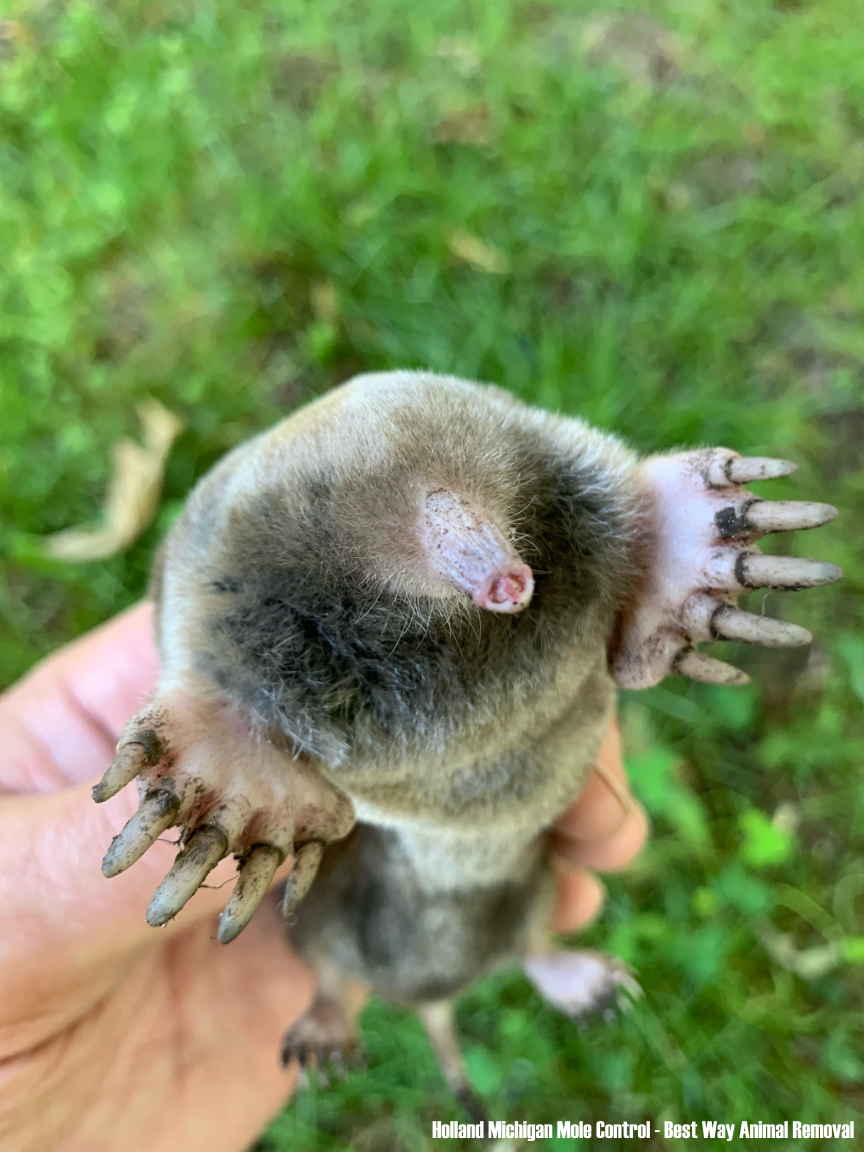Introduction
Nuisance moles are a common problem for homeowners and gardeners. They can cause significant damage to lawns and gardens, and their tunneling can create potential hazards. In this article, we’ll discuss how to identify nuisance moles, the damage they can cause, and effective methods for mole control and prevention them.
Understanding Nuisance Moles
 Moles are small, burrowing mammals that are adapted to living underground. They are part of the Talpidae family, which includes shrews and other subterranean mammals. Moles are typically around 5-7 inches in length and have small eyes and ears, since they spend most of their time underground. Their fur is dense and velvety, and ranges from grayish-brown to black. They have large, spade-like front paws that they use for digging, and their hind feet are webbed, which allows them to move efficiently through the soil.
Moles are small, burrowing mammals that are adapted to living underground. They are part of the Talpidae family, which includes shrews and other subterranean mammals. Moles are typically around 5-7 inches in length and have small eyes and ears, since they spend most of their time underground. Their fur is dense and velvety, and ranges from grayish-brown to black. They have large, spade-like front paws that they use for digging, and their hind feet are webbed, which allows them to move efficiently through the soil.
Moles are solitary creatures that are active year-round, but are most active during the spring and fall. They are primarily insectivores, and their diet consists mainly of earthworms, insects, and other small invertebrates that they find while tunneling through the soil. Moles are able to detect their prey through their sense of touch and smell, and they use their powerful front paws to dig tunnels and create underground burrows where they store food and raise their young.
Moles are able to dig quickly through soil due to their specialized anatomy. Their front paws are equipped with large, sharp claws that they use to dig through dirt and create tunnels. They also have a specialized bone in their skull called the premaxilla, which allows them to move their nostrils independently from their mouth, which is important for detecting prey while underground. Additionally, moles have a high metabolic rate and require a lot of food to sustain their energy levels. As a result, they are constantly tunneling through the soil in search of food.
Damage Caused by Nuisance Moles
Nuisance moles can cause significant damage to lawns and gardens. Their tunneling can uproot plants, cause soil erosion, and create unsightly ridges in lawns. In addition, their tunneling can create potential hazards by undermining sidewalks, driveways, and other structures. Moreover, moles carry parasites and diseases, such as rabies, that can be harmful to human health and safety.
Moles are especially damaging to lawns and gardens because their tunneling can uproot plants, cause soil erosion, and create unsightly ridges in lawns. When they tunnel, they create air pockets in the soil, which can cause grass and other plants to dry out and die. This can make it difficult to grow healthy plants and create a lush, green lawn. Moreover, moles can create potential hazards by undermining sidewalks, driveways, and other structures. The tunnels they create can cause the ground to become unstable and lead to damage to these structures. Furthermore, moles can carry parasites and diseases that can be harmful to human health and safety. Moreover, Rocky Mountain spotted fever, a tick-borne bacterial illness comparable to anaplasmosis and Lyme disease, can also be spread by moles. This illness can be fatal in severe cases and is characterized by rash, fever, and headaches.
Methods for Controlling Nuisance Moles
There are various methods for controlling nuisance moles, both natural and lethal. Trapping and relocating is a humane and effective method for controlling mole populations. Repellents are also a natural way to deter moles from settling in your lawn or garden. However, lethal methods such as poison baits and fumigation are sometimes necessary when other methods fail. Tunnel destruction is also an effective method, which involves collapsing the tunnels that moles have built.
Prevention of Nuisance Moles
Prevention is the best way to avoid mole problems. Habitat modification, such as removing thick vegetation and other mole-friendly habitats, can discourage moles from settling in your lawn or garden. Barrier installation, such as fencing or mesh, can also help prevent moles from gaining access to your property. Vegetation management, including proper watering and fertilizing, can create a healthy lawn that is less susceptible to mole damage.
Hiring a Professional
When mole problems happen, it’s necessary to hire a professional wildlife control service. Our professional service can help you identify the root of the problem and provide effective solutions tailored to your specific situation. It’s important to choose a reputable, licensed animal removal service to ensure the safety of you, your family, and your pets during the mole trapping process.
Conclusion
Nuisance moles can cause significant damage to your lawn and garden, as well as pose potential hazards to human health and safety. It’s important to understand the problem and the various methods for controlling and preventing it. By implementing effective solutions and, if necessary, hiring a professional service, you can protect your property and maintain a healthy, beautiful lawn and garden.
